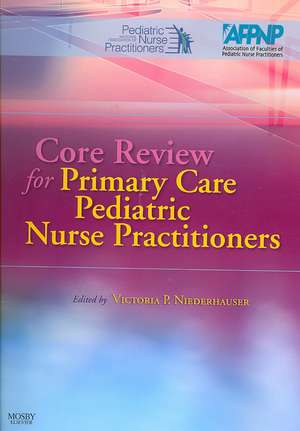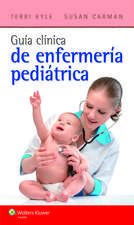Core Review for Primary Care Pediatric Nurse Practitioners
Autor National Association of Pediatric Nurse, Association of Faculties of Pediatric Nu Editat de Victoria Page Niederhauseren Limba Engleză Paperback – 16 apr 2007
Preț: 241.91 lei
Preț vechi: 254.65 lei
-5% Nou
Puncte Express: 363
Preț estimativ în valută:
46.29€ • 48.33$ • 38.31£
46.29€ • 48.33$ • 38.31£
Carte disponibilă
Livrare economică 14-28 martie
Livrare express 27 februarie-05 martie pentru 42.00 lei
Preluare comenzi: 021 569.72.76
Specificații
ISBN-13: 9780323027571
ISBN-10: 0323027571
Pagini: 424
Dimensiuni: 184 x 260 x 17 mm
Greutate: 0.77 kg
Ediția:1
Editura: Elsevier
Locul publicării:United States
ISBN-10: 0323027571
Pagini: 424
Dimensiuni: 184 x 260 x 17 mm
Greutate: 0.77 kg
Ediția:1
Editura: Elsevier
Locul publicării:United States
Cuprins
Section 1: Role of the Pediatric Nurse Practitioner
1. Evolution of the Pediatric Nurse Practitioner Role
2. Essential Elements of the Advanced Practice Role for Pediatric Nurse Practitioners
3. Clinical Reasoning and Clinical Decision Making
Section 2: Health Assessment and Physical Examination
4. Measures of Child Growth and Development
5. Assessment of the Head, Eyes, Ears, Nose and Throat
6. Assessment of the Pulmonary System
7. Assessment of the Cardiovascular System
8. Assessment of the Gastrointestinal System
9. Assessment of the Reproductive and Urologic Systems
10. Assessment of the Integumentary System
11. Assessment of the Hematologic and Lymphatic Systems
12. Assessment of the Musculoskeletal System
13. Assessment of the Neurologic System
Section 3: Special Topics in Health Promotion and Disease Prevention
14. Core Concepts in Genetics
15. Immunizations
16. Nutrition
17. Preconceptional and Prenatal Role
18. Care of the Newborn Before Hospital Discharge
19. Newborns and Infants
20. Preterm Infant Follow-up Care
21. Child Abuse and Neglect
22. Toddlers, Preschoolers, and School-agers
23. Mental Health Promotion and Mental Health Screening for Children and Adolescents
24. Sports Participation: Evaluation and Monitoring
25. Early Adolescents, Late Adolescents, and College-age Young Adults
26. Sexuality and Birth Control
Section 4: Diagnosis and Management of Common Illness in Children and Adolescents
27. Common Illness of the Head, Eyes, Ears, Nose and Throat
28. Common Illness of the Pulmonary System
29. Common Illness of the Cardiovascular System
30. Common Illness of the Gastrointestinal System
31. Common Illness of the Reproductive and Urologic Systems
32. Common Illness of the Integumentary System
33. Common Illness of the Hematologic and Lymphatic Systems
34. Common Illness of the Musculoskeletal System
35. Common Illness of the Neurologic System
Section 5: Diagnosis and Management of Chronic Conditions in Children and Adolescents
36. Asthma
37. Cerebral Palsy
38. Childhood Cancer
39. Cleft Lip and Palate
40. Common Genetic Conditions in Children
41. Common Mental Health Disorders in Children and Adolescents
42. Congenital Heart Disease
43. Cystic Fibrosis
44. Diabetes Types 1 and 2
45. Eating Disorders
46. Epilepsy
47. Hemoglobinopathies
48. Juvenile Rheumatoid Arthritis
49. Learning Disorders and Attention Deficit Hyperactivity Disorder
50. Chronic Renal Failure in Children
51. Spina Bifida and Other Myelodysplasias
Section 6: Diagnostic, Medication, and Treatment Guides for Children and Adolescents
52. Readiness for Handling Pediatric Emergencies in the Primary Care Office
53. Diagnostic Tests for Pediatric Clinical Decision Making
54. Pharmacodynamic Considerations Unique to Neonates, Infants, Children, and Adolescents
55. Pain Management for Children
56. Complementary and Alternative Therapy
57. Nonpharmacologic Treatments and Pediatric Procedures
Section 7: Using Evidence-Based Practice to Improve Outcomes in Outpatient Settings
58. Evolving Roles for Pediatric Nurse Practitioners
1. Evolution of the Pediatric Nurse Practitioner Role
2. Essential Elements of the Advanced Practice Role for Pediatric Nurse Practitioners
3. Clinical Reasoning and Clinical Decision Making
Section 2: Health Assessment and Physical Examination
4. Measures of Child Growth and Development
5. Assessment of the Head, Eyes, Ears, Nose and Throat
6. Assessment of the Pulmonary System
7. Assessment of the Cardiovascular System
8. Assessment of the Gastrointestinal System
9. Assessment of the Reproductive and Urologic Systems
10. Assessment of the Integumentary System
11. Assessment of the Hematologic and Lymphatic Systems
12. Assessment of the Musculoskeletal System
13. Assessment of the Neurologic System
Section 3: Special Topics in Health Promotion and Disease Prevention
14. Core Concepts in Genetics
15. Immunizations
16. Nutrition
17. Preconceptional and Prenatal Role
18. Care of the Newborn Before Hospital Discharge
19. Newborns and Infants
20. Preterm Infant Follow-up Care
21. Child Abuse and Neglect
22. Toddlers, Preschoolers, and School-agers
23. Mental Health Promotion and Mental Health Screening for Children and Adolescents
24. Sports Participation: Evaluation and Monitoring
25. Early Adolescents, Late Adolescents, and College-age Young Adults
26. Sexuality and Birth Control
Section 4: Diagnosis and Management of Common Illness in Children and Adolescents
27. Common Illness of the Head, Eyes, Ears, Nose and Throat
28. Common Illness of the Pulmonary System
29. Common Illness of the Cardiovascular System
30. Common Illness of the Gastrointestinal System
31. Common Illness of the Reproductive and Urologic Systems
32. Common Illness of the Integumentary System
33. Common Illness of the Hematologic and Lymphatic Systems
34. Common Illness of the Musculoskeletal System
35. Common Illness of the Neurologic System
Section 5: Diagnosis and Management of Chronic Conditions in Children and Adolescents
36. Asthma
37. Cerebral Palsy
38. Childhood Cancer
39. Cleft Lip and Palate
40. Common Genetic Conditions in Children
41. Common Mental Health Disorders in Children and Adolescents
42. Congenital Heart Disease
43. Cystic Fibrosis
44. Diabetes Types 1 and 2
45. Eating Disorders
46. Epilepsy
47. Hemoglobinopathies
48. Juvenile Rheumatoid Arthritis
49. Learning Disorders and Attention Deficit Hyperactivity Disorder
50. Chronic Renal Failure in Children
51. Spina Bifida and Other Myelodysplasias
Section 6: Diagnostic, Medication, and Treatment Guides for Children and Adolescents
52. Readiness for Handling Pediatric Emergencies in the Primary Care Office
53. Diagnostic Tests for Pediatric Clinical Decision Making
54. Pharmacodynamic Considerations Unique to Neonates, Infants, Children, and Adolescents
55. Pain Management for Children
56. Complementary and Alternative Therapy
57. Nonpharmacologic Treatments and Pediatric Procedures
Section 7: Using Evidence-Based Practice to Improve Outcomes in Outpatient Settings
58. Evolving Roles for Pediatric Nurse Practitioners






